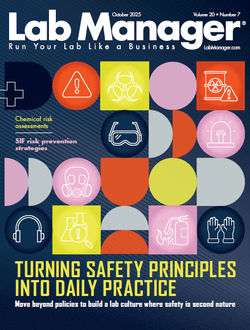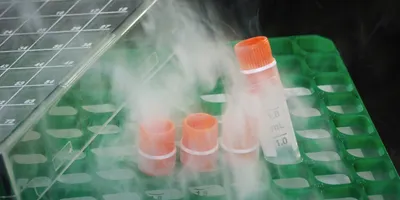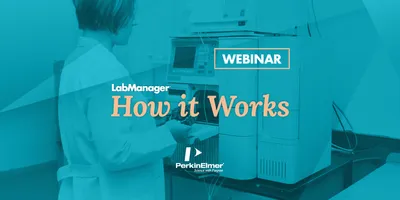
Just as Henry Ford applied automation to car manufacturing and the McDonald brothers introduced automation to fast food, laboratory science is currently undergoing its own automation revolution. And just as it did for the car and fast-food industries, this push toward automation is changing the way laboratories do business.
Countless processes—from the highly complex to the simple and routine—are amenable to automation. Clinical diagnostics, food safety, and synthetic biology are just a few of the disciplines where automation is already in high demand, and numerous others are beginning to follow suit. The shift is not without its challenges, but with proper management and foresight, labs in both industry and academia are reaping the benefits of automation.
Many reasons to automate
 Barcode reader on the automated line at UAB.Image credit: UAB“It’s often simply more time- and cost-effective to automate, especially when throughput is needed,” says Mary Blair, scientific leader of NGS at Hamilton Robotics (Reno, NV). Predictably, some of the earliest adopters of automation have been high-throughput screening and sample management labs, according to Ian Yates, senior marketing manager for lab automation at Thermo Fisher Scientific (Waltham, MA). “However, as the laboratory automation industry has matured and the benefits of automation have proven to be greater than just speed, the breadth of labs looking to automate has increased dramatically,” he says.
Barcode reader on the automated line at UAB.Image credit: UAB“It’s often simply more time- and cost-effective to automate, especially when throughput is needed,” says Mary Blair, scientific leader of NGS at Hamilton Robotics (Reno, NV). Predictably, some of the earliest adopters of automation have been high-throughput screening and sample management labs, according to Ian Yates, senior marketing manager for lab automation at Thermo Fisher Scientific (Waltham, MA). “However, as the laboratory automation industry has matured and the benefits of automation have proven to be greater than just speed, the breadth of labs looking to automate has increased dramatically,” he says.
For UAB Hospital in Birmingham, Alabama, which invested $6.8 million in an automated lab that opened last year, the newly automated process improved the quality of their testing services. In order to process samples on the new instruments and line, the hospital was required to start bar coding their specimens. Sherry Polhill, associate vice president of UAB Hospital lab, respiratory care, and pulmonary function areas, recalls that prior to automation, none of the nursing units in the hospital used bar-coded tubes. “We’re an over 1,000-bed hospital, so that process alone to get every floor and unit bar code compliant took us over a year to do,” she says. “But that’s added quality because you no longer have to wonder if samples were collected correctly.”
Ergonomics is another area that can benefit from lab automation. Companies and core labs are increasingly focused on ergonomics because repetitive stress and strain from certain manual tasks, such as pipetting, can take a toll on employee productivity and well-being. “Automation takes over those more mundane tasks to eliminate the risk of repetitive injuries and also to free users to focus on other tasks,” says Blair.
According to Louis Scampavia, co-director of the high-throughput screening lead identification division at The Scripps Research Institute in Florida, lab automation is not only beneficial—in many cases, it is indispensible. “There are tasks that are just not suitable for people to do because they involve such small, high-density plates,” he says. A combination of automation and miniaturization has enabled these types of processes to be carried out routinely in Scampavia’s laboratory.
Bumpy roads
Lab automation is bringing positive change to a wide range of disciplines, but it is not without its challenges. The task of automating can be particularly daunting for labs that are navigating uncharted territory. Richard Thomson, the director of clinical microbiology laboratories at NorthShore Research Institute in Evanston, Illinois, had the first lab in the U.S. to apply automation to bacteriology. For Thomson, the initial challenge was convincing the staff that doing away with manual processes was a good idea. “Microbiology is a very manual science—probably the least automated of just about all the laboratories in pathology—and some people felt it would never be able to be automated,” he says. But the leaders were convinced that automation was the way to go.
Related Webinar: Automation for Improved Results
The switch didn’t happen quickly. “It took about six months to get all of the bugs out of the system,” says Thomson. For instance, for a time, when the automated system attempted to pull the lid off a petri dish, it would pick up the base of the dish as well. Then there was the task of training the technologists to use the new, highly computerized instrumentation. As might be expected, the learning curves broke down into age brackets. “Those that learned in a week or two were all in their 30s, those that took a couple of months were in their 50s, and those that took a year were in their 60s,” he says.
 Petri dishes moving along an automated trackImage courtesy of the microbiology lab at NorthShore University HealthSystemEven the space allocated to the automated instruments can pose a challenge, as Polhill can attest. She notes that it is easier to create a new space from scratch than it is to renovate an existing one. If the infrastructure of the building is old, then factors like the condition of plumbing and electrical boxes and even how much weight the floor can support all must be evaluated. “If you’re building a new house, you put in the specs up front, but if you’re renovating an older home, you usually have to redo something,” she says, “and we had to redo a lot.”
Petri dishes moving along an automated trackImage courtesy of the microbiology lab at NorthShore University HealthSystemEven the space allocated to the automated instruments can pose a challenge, as Polhill can attest. She notes that it is easier to create a new space from scratch than it is to renovate an existing one. If the infrastructure of the building is old, then factors like the condition of plumbing and electrical boxes and even how much weight the floor can support all must be evaluated. “If you’re building a new house, you put in the specs up front, but if you’re renovating an older home, you usually have to redo something,” she says, “and we had to redo a lot.”
Finding success
Yates advises that a critical first step when considering lab automation is to define what constitutes a successful implementation. “Is success a solution that delivers extra capacity or that increases data quality or that frees up lab staff or all of these?”
There may be multiple ways to measure success, but from a financial perspective, labs spending considerable amounts on automation all seek a return on their investment. Polhill believes that attaining the coveted ROI comes down to a single factor: labor. “To make it profitable, you have to be able to reduce labor,” she says. That’s because the greatest cost of running a project—between 70 and 80 percent, according to Scampavia—is associated with staffing. “If you can get more productivity from the people or it takes fewer people to get the job done, then that becomes a measure of ROI,” he says.
There may be other, less direct means of paying off an automated instrument. For example, Thomson’s lab calculated the extent to which automation reduced the turnaround time for results to come in, which served to shorten the length of stay for patients waiting for bacteriology lab tests. The shortened visits translated to hundreds of thousands of dollars in savings. Nonetheless, it was still the fact that the new instrument enabled the lab to cut about 20 percent of its workforce that Thomson used as his primary justification for the purchase.
Lab Quality Management Certificate
The Lab Quality Management certificate is more than training—it’s a professional advantage.
Gain critical skills and IACET-approved CEUs that make a measurable difference.
Win-win
Reduction in labor is an unavoidable consequence of lab automation, but it does not always mean job loss. Years before the automated lab at UAB Hospital materialized, Polhill began developing other businesses to launch as soon as the automation went live. This strategy enabled the hospital to repurpose trained staff members who were already familiar with the culture, the language, and the patients for positions in new or growing businesses, like the hospital’s lab medicine customer service area, a diagnostic molecular lab, and a drug confirmation lab.
When automation opens up new and more challenging roles, it is often a boon to both the business and the staff. “Using smaller, user-friendly systems to automate routine, tedious tasks can not only enhance reproducibility and eliminate user error,” says Stephanie Franco, a technical product manager at BrandTech Scientific (Essex, CT), “but it can also boost morale and productivity by freeing up your scientists to do science instead of the drudgery of being a human doing robot things.”
The right vendor
After the decision to implement automation has been made and goals have been narrowed down, a vendor must be chosen. The key, according to Scampavia, is to look beyond the instrumentation itself. “Look a little deeper at what vendors have to offer in terms of software and support,” he says, noting that people planning an automation project are sometimes “penny wise and pound foolish”—they focus on how little they can pay for the hardware without considering what support they will require in order to be productive.
Automation, says Blair, is a long-term commitment, so it is important to be comfortable with the product you choose. To that end, she recommends taking a proactive approach with potential vendors. “Bring them in for software demos, work one-on-one with them to personalize your automation solution, and ask about training and post-installation service and support.”
Words to the wise
Converting a manual process into an automated one requires a shift in thinking, according to Yates. “It’s not simply employing a robot to do the steps a human does, but taking a holistic view of the entire process and optimizing it for an automated approach.”
Getting outside perspectives can help guide a lab’s vision for automation and also uncover potential snags before they appear. “Get some consultants or people you can call and feel comfortable with,” Polhill advises. Bringing to the table experts who have already been through the process is especially critical for those who have never implemented automation before.
Thomson attributes his laboratory’s success with automation to leadership. “We trained people well, and the leaders were able to keep people focused on the benefits of automation down the road.” He recalls there was a stretch of time, before the automation was running smoothly, when the lab members could have easily gotten discouraged and reverted to the old methods. “If you don’t have the right leadership and the lab is not open to experimentation and trial, you’ll never get there,” he says.
“My recommendation is to have an open mind and let the automation help you do it better.”













